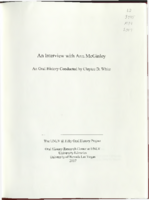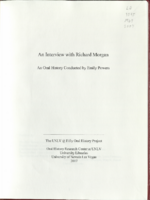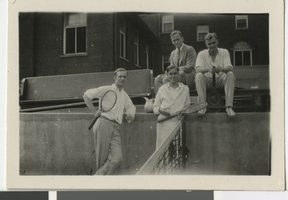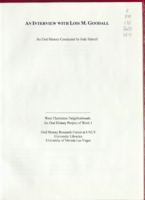Search the Special Collections and Archives Portal
Search Results

Transcript of interview with Carol Harter by Suzanne Becker, April 20, 2007
Date
Archival Collection
Description
Carol Harter and her husband of 46 years started their married lives by running away from college in their sophomore year. They spent the 60's working toward their degrees. Carol earned her bachelor's in 1964 and her master's in 1967. One of her professors encouraged her to go for her PhD at a time when women simply did not aspire to such heights. Dr. Harter completed her PhD in 1970, and because her husband wanted to work on his doctorate, they moved to Athens, Ohio. She taught at Ohio University while he completed his courses. They lived and worked and raised their children there for 19 years. Carol held the positions of ombudsman (2 years), vice president and dean of students combined (6 years), and vice president at the university, and then accepted the position of president at SUNY Geneseo (in New York). Carol was nominated for the presidency at UNLV in 1994, and she accepted the job in 1995. Her career here has been phenomenal, as she saw the potential of this very young university and set about bringing in the faculty, the funding, the buildings, and the vision to create a first-rate research oriented facility. During her administration, the new library went up, the law school and dental school were built, and over 550 million in gifts and pledges were raised. This includes money raised for the "Invent the Future" campaign. Under Dr. Harter's guidance, women's sports were expanded, multiple graduate degrees were developed, more money for research and buildings was raised, and UNLV has become a major research university. Dr. Harter leaves behind a rich legacy, including her vision of the UNLV Midtown project, a cultural district where the university may one day interface with the community.
Text

Transcript of interview with Lestor Burgwardt by Connie Carr, February 9, 1980
Date
Archival Collection
Description
On February 9, 1980 collector Connie Carr interviewed teacher, Lestor Burgwardt (born May 24, 1926 in Hamburg, New York) in his home in Las Vegas, Nevada. This interview covers local entertainment, Lake Mead, school districts, and gaming’s effect on the educational system. Lestor also recalls his move to Nevada and offers a general overview of Henderson in 1954.
Text

Transcript of interview with Ann McGinley by Claytee D. White, August 01, 2006
Date
Archival Collection
Description
Text

Transcript of interview with Richard Morgan by Emily Powers, November 7, 2006
Date
Archival Collection
Description
Text
Janet Saxton oral history interview
Identifier
Abstract
Oral history interview with Janet Saxton conducted by Francine Gordon on November 10, 2006 for the Public School Principalship Oral History Project. In this interview, Saxton reflects upon her twenty years as a teacher and administrator with Nevada’s Clark County School District. She discusses the interactions between teachers and principals, and challenges that she faced in fostering relationships with teachers. She then describes her personal approach to school administration, and discusses how her upbringing and experiences shaped that approach.
Archival Collection

Photograph of students, Philadelphia (Penn.), 1922-1926
Date
Description
Image

Transcript of Lois M. Goodall by Judy Harrell, November 12, 2013
Date
Archival Collection
Description
Text

Transcript of an interview with Kenneth Fong by Lois Goodall on February 22, 2014
Date
Archival Collection
Description
Text
Richard Erbe oral history interview
Identifier
Abstract
Oral history interview with Richard Erbe conducted by Marcela Yepes on March 19, 1978 for the Ralph Roske Oral History Project on Early Las Vegas. In this interview Erbe discusses his educational background, his first teaching position as a fifth grade teacher, and his military experience. He also talks about church activity, politics, and social activities in Las Vegas, Nevada. Erbe also discusses his views on the educational system, his experiences as a principal, and some challenges he encountered at the administrative level.
Archival Collection

Transcript of interview with Judy Laliberte by LaVaun Hendrix, February 27, 1979
Date
Archival Collection
Description
On February 27, 1979, collector Judy Laliberte interviewed local school teacher LaVaun Hendrix in her home in Las Vegas, Nevada. The two discuss how Hendrix originally came to Nevada, her occupational history, and differences between the school system in Las Vegas and other states that she’s lived in. Hendrix explains how a changing school system has affected her job as a teacher and her students. She goes on to talk about the above-ground atomic tests, Helldorado, changes to the desert, and Nevada during World War II. The interview concludes with Hendrix describing her travels through Nevada.
Text
